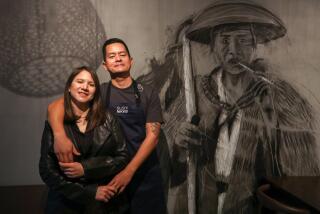STYLE : STYLEMAKERS : United in Spirit
- Share via
If you were looking for a couple who could personify the Pacific Rim melding of cultures, designers James and Christine Nakaoka would do nicely. James, the 39-year-old son of a Japanese set designer who worked with John Huston, was born in Los Angeles, grew up in Tokyo and spent much of his youth living in the Frank Lloyd Wright-designed Imperial Hotel. Christine, 37, is the granddaughter of a cosmopolitan Korean industrialist. They met as “all-American students” at the architecture school of Cal Poly San Luis Obispo. Together, they run a very Western architecture and design office in West Los Angeles that has produced several major projects, including a pan-European palazzo for the store Bergdorf Goodman Men in New York, vaguely classical “play temples” for Imaginarium toy stores and a pedimented facade for Petite Sophisticates in the Beverly Center. In the works are dioramas of great automotive moments (drive-ins, family picnics) for the automobile museum of the Museum of Natural History, plus the Ansel Adams Gallery in Yosemite and a Monterey Bay Aquarium addition.
The Nakaokas’ work looks vaguely Western but has a serenity and an elegance that is distinctly Eastern. They define it with the Japanese term shibui. “It means somewhat tart, or bitter,” explains James, “not as an insult, but implying depth or spirit below the surface.” “It is like a patina,” says Christine, “something a child wouldn’t understand. You have to have experienced life.”
The Nakaokas are now applying their grown-up sensibilities to the interior of the Japanese American National Museum, set to open this spring in Little Tokyo. The museum will be housed in a former Buddhist temple built in 1925. It still has, according to Christine, “a wonderful kind of crudeness, a directness that came from not having a lot of money.” Rather than hide this, the Nakaokas are trying to bring it out through restoration and by adding their own touches. They feel the project has helped them as designers. “I’m noticing the Japanese influences in my work more and more. In school, we thought we were just like everybody else, but now we realize that we are bringing our background into our designs,” Christine says. Adds James: “We learned how to make things look right here, but in Japan, you always ask, ‘Does it feel right?’ We want to go beyond surfaces, beyond organizing spaces. We want to make spaces that feel right.”


